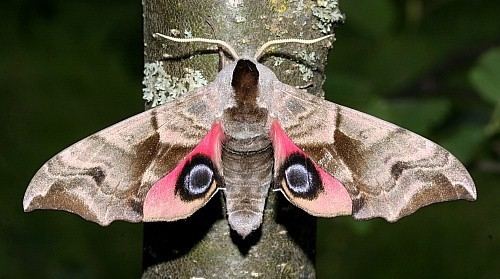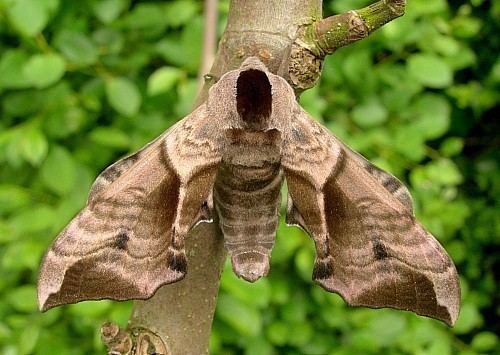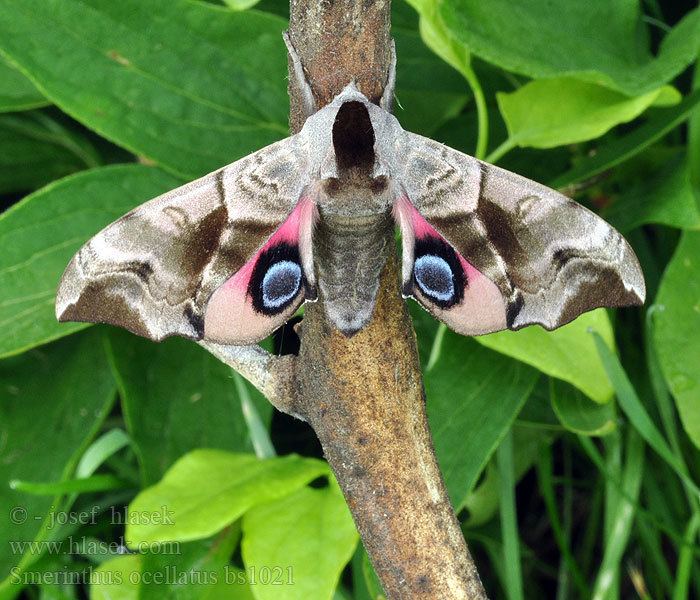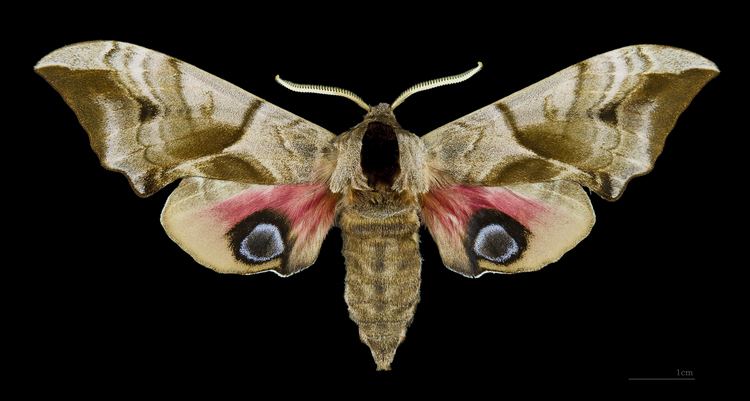Higher classification Smerinthus | Scientific name Smerinthus ocellatus Rank Species | |
 | ||
Similar Smerinthus, Sphingidae, Butterflies and moths, Laothoe populi, Mimas tiliae | ||
Smerinthus ocellatus, known as the eyed hawk-moth, is a European moth of the family Sphingidae.
Contents
The eyespots are not visible in resting position, where the forewings cover them. They are displayed when the moth feels threatened, and may startle a potential predator, giving the moth a chance to escape.

Imago

Very similar in appearance to the other two western Palaearctic Smerinthus species, Smerinthus caecus and Smerinthus kindermannii but differentiated by an apical thorn on the foretibia, and the large, circular hindwing ocellus.The upperside forewings are marked in light and dark shades of brown and resemble the coloring of bark. The hindwings are pink coloured basally and then a yellow ochre.The hindwings are dominated by a large, blue, dark-centered and black-rimmed eyespot. The thorax has light brown sides and dark brown hairs in the middle.In addition to variations in the density of the forewing pattern intensity, differences in colour are also found on the hindwing. In f. flavescens Neumann hindwing pink is replaced by yellow in f. pallida Tutt by grey and in f. albescens Tutt. In f. rosea Bartel, the pink is deep and the forewings are yellowish brown; in f. ollivryi Oberthür, the ocellus is replaced by a buff brown patch. The adult moth has a wingspan of 70–80 millimetres (2.8–3.1 in).
Historical description
Edward Newman described it thus:

The Eyed Hawk-Moth, so called from a large and beautiful spot in each of the hind wings that somewhat resembles an eye. The fore wings are brown, with a very beautiful reddish bloom over them, and clouded with olive-brown. The hind wings are of a delicate rosy red at the base, and a pale brown towards the margin; and each has a large and beautiful eye-like spot, grey in the centre, surrounded with blue, and the blue surrounded by a black ring. The skin of the caterpillar is rough, like shagreen; it is pale green, sprinkled with white, and has seven oblique white stripes on each side. The horn at the tail is blue. It is very common in the autumn, feeding on apple trees in gardens, and on willow bushes in hedges. The chrysalis is red-brown, and glossy. The Moth is found about Midsummer.
Larva

The larva is pale bluish or yellowish green with small white-tipped tubercules and a grey-blue tail horn. The sides are striped white or yellow and the spiracles are white ringed with dark red. The larvae grow to about 80 mm. The larval foodplants are various species of Salix, Populus and Malus
Pupa

The pupa is glossy reddish-brown, and is formed below the soil surface in late summer, where it overwinters. The adults emerge the following summer in May or June.
Sub-species
Smerinthus ocellatus atlanticus is sometimes treated as a full species, in which case Smerinthus atlanticus protai is placed as a subspecies of this species, rather than Smerinthus ocellatus.
Nomenclatural note
The name Smerinthus is apparently derived from the Greek feminine noun 'Merinthos', but has been Latinised with the masculine -us ending and is thus, according to the ICZN article 30.1.3, masculine. As the ICZN rules that species names that are adjectives should agree in gender with the genus name, the common use of Smerinthus ocellata for this species is incorrect.
